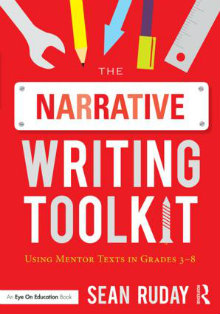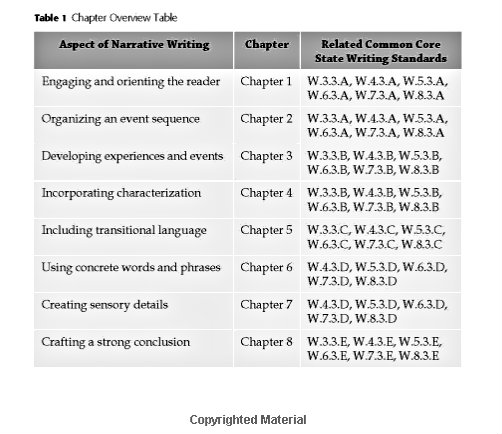Narrative Writing Ideas Built on Mentor Texts
The Narrative Writing Toolkit: Using Mentor Texts in Grades 3-8
By Sean Ruday
(Routledge/Eye on Education, 2016 – Learn more)

The Narrative Writing Toolkit Using Mentor Texts in Grades 3-8 by Sean Ruday is an essential for teachers of writing across the country. Ruday’s practical ideas and teaching strategies should reduce their stress levels considerably.
He will also save you time, since he’s included excerpts from the published works featured in his book. And don’t be misled by the grade designation. If you work with high school students who are struggling with narrative writing, I recommend checking out this title.
Inside the book
This 160-page book is divided into three sections. The first focuses on narrative writing strategies aligned to the Common Core Standards.
Section 2 focuses on “Putting It Together” (strategies, assessment, and recommendations for putting Ruday’s ideas into practice). The final section, Resources, includes reproducible charts and forms, along with a guide for a book study, an annotated bibliography, and the book’s reference list.
I found this book to be very teacher friendly. The chapters are organized into an easy-to-follow format. Ruday begins each with an explanation of the focal concept and then explains why that concept is important to effective narrative writing.
The Classroom Snapshot provides a description of his own experiences in teaching the concept. He includes recommendations – with detailed discussions – for teaching the focal concept. Each chapter ends with his Final Thoughts on the focal concept.
How writers engage and orient the reader

To illustrate these two strategies he begins with Kate DiCamillo’s The Tale of Despereaux and Lemony Snicket’s The Bad Beginning.
Ruday provides readers with a step-by-step instructional process to use when teaching students about engaging and orienting readers. It’s easy to see the Gradual Release of Responsibility method at work as he teaches how to improve narrative writing.
Mentor texts for to reinforce transitional language
I was particularly intrigued by Chapter 5, Including Transitional Language. To illustrate the concept of transitional language, Ruday uses Millions, a novel by Frank Cottrell Boyce, My Teacher Flunked the Planet by Bruce Coville, and Escape from Mr. Lemoncello’s Library by Chris Grabenstein.
My experience has been that students can name the transitional words, but somehow never incorporate them into their writing. Perhaps by examining these mentor texts, along with focused teaching, students will apply this strategy to their writing.
The Narrative Writing Toolkit Using Mentor Texts in Grades 3-8 is an excellent choice for your book study group. Check out Dr. Ruday’s other Toolkit books here.
Read a MiddleWeb article by Sean Ruday
Anne Anderson is an educational consultant known for her practical ideas and engaging ELA workshops. Anne’s goal is to help teachers help students. Her positive approach and sense of humor bring encouragement to her audiences. Anne seeks to provide educators with practical solutions to teaching and learning problems. Visit her website and subscribe to her bi-monthly newsletter, Spotlight on Success.



































